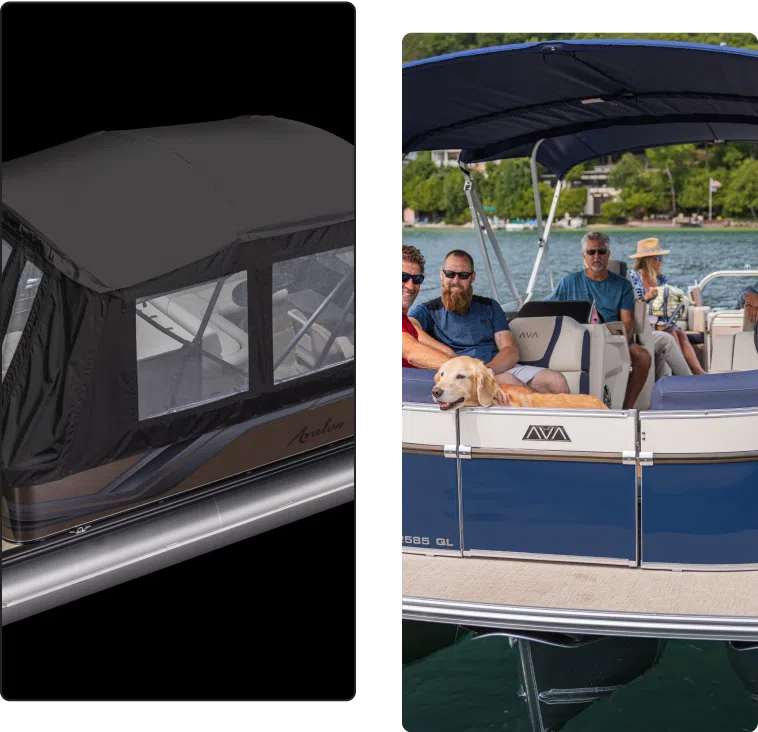
UV rays, often underestimated, are perhaps the most persistent enemy. Constant sun exposure can fade your upholstery, crack your vinyl, and even degrade your boat’s structural integrity over time. What was once a vibrant, comfortable space can quickly become a dull, uninviting area that’s costly to restore.
Rain and humidity pose their own set of challenges. Water that pools on your boat can lead to mold and mildew growth, potentially damaging your boat’s interior and sensitive electronics. In colder climates, snow and ice accumulation can put stress on your boat’s frame and cause serious structural damage.
But the threats don’t stop there. Dust, leaves, bird droppings, and other debris can stain surfaces, clog drains, and create an unsightly mess. And let’s not forget about curious critters looking for a cozy home—an uncovered boat can quickly become a haven for nesting animals.
A quality pontoon boat cover acts as a shield against all these elements. It’s not just about maintaining your boat’s showroom shine; it’s about protecting your investment, reducing maintenance costs, and ensuring your pontoon is always ready for your next adventure.
Mooring covers are your boat’s cozy robe when it’s relaxing at the dock or on a lift. They provide solid protection while allowing easier access than full covers. Many boaters use these as their primary cover during the boating season.
Designed for life on the road, tough travel covers shield your boat from debris and wind damage during transport. They’re typically more durable and secure than other types to withstand highway speeds.
For the pontoon owner who values a sleek look, custom-fit snap-on covers attach to snaps installed on your boat. They offer a tight, tailored fit but require professional installation of the snaps.


Polyester is lightweight, affordable, and offers decent protection. Solution-dyed polyester resists fading and can handle moderate weather conditions. However, it may not stand up to extreme conditions as well as other materials.
Acrylic offers superior UV resistance and breathability, making it ideal for sunny climates. Acrylic covers, like Sunbrella, maintain their color longer and resist mildew better than polyester. The downside? They come with a heftier price tag.
Your pontoon’s perfect cover depends largely on your local climate. Let’s navigate through different weather scenarios:
In sunny and hot climates, prioritize UV protection and breathability, looking for light-colored acrylic fabrics like Sunbrella in covers that include vents to prevent heat buildup and condensation.
In rainy regions, make sure your fabric is water repellent and quick drying, like marine-grade polyester or Seal Skin, in a cover with waterproof coatings and reinforced seams.
In snowy areas, your cover will need to be heavy-duty and durable like Seal Skin, with snow shedding capabilities, a steep pitch to prevent snow accumulation, and strong support poles.
In coastal environments, aim for solution-dyed polyester or acrylic that’s salt-, wind-, and mildew-resistant, with reinforced tie-downs in the cover.

Journey with Avalon: Pioneering 5 Decades of Unmatched Pontoon Luxury. Where Art, Quality, and Service Converge for Your Ultimate Water Adventure.
By following these installation and maintenance steps, you’ll protect your pontoon and maximize your cover’s lifespan, ensuring many seasons of worry-free boating ahead. For more personalized advice or to explore the latest models, consider visiting a pontoon boat dealer. They can provide expert insights and help you choose the right cover to suit your needs.

Armed with this knowledge, you can now make an informed decision that best suits your pontoon and your specific needs. Remember, the perfect cover acts as a shield, protecting your prized possession from UV rays, rain, snow, and debris.
It’s not just about preserving your boat’s appearance; it’s about maintaining its value and functionality for years to come. By taking the time to select the right cover and properly care for it, you’re ensuring that your pontoon will be ready for adventure whenever you are.
So, don’t leave your pontoon’s fate to chance. Invest in quality protection today and look forward to many worry-free seasons of fun on the water tomorrow.
If you’re interested in additional features, such as a pontoon boat with slide, exploring specialized covers and maintenance tips for these models can further enhance your boating experience.
Embark on 50 years of award-winning pontoon excellence with Avalon. Elevate your journey through unrivaled artistry, cutting-edge design, and supreme quality and service.
Copyright © 2024 Avalon Pontoon Boats. All Rights Reserved. Sitemap
Copyright © 2022 Avalon Pontoon Boats. All Rights Reserved. Sitemap
Send your message to the dealer
One of our Pontoon specialist or a local dealer near you will contact you to help configure the boat that matches your exact needs.
Thank you for taking the time to contact us with your questions and concerns. We love being available for you electronically. Recently, though, we have begun to receive duplicate emails sent to multiple people in the company. In an effort to increase our efficiency and improve our customer service, we would appreciate it if you use our online contact us form to the right so we can automatically direct your request to the correct people on our team.
If you are in need of service regarding a warranty, please contact your dealer (find your local dealer here). Contact us only if your dealer’s service does not meet your needs.
Thank you,
The Avalon Team
903 Michigan Avenue,
Alma, MI 48801